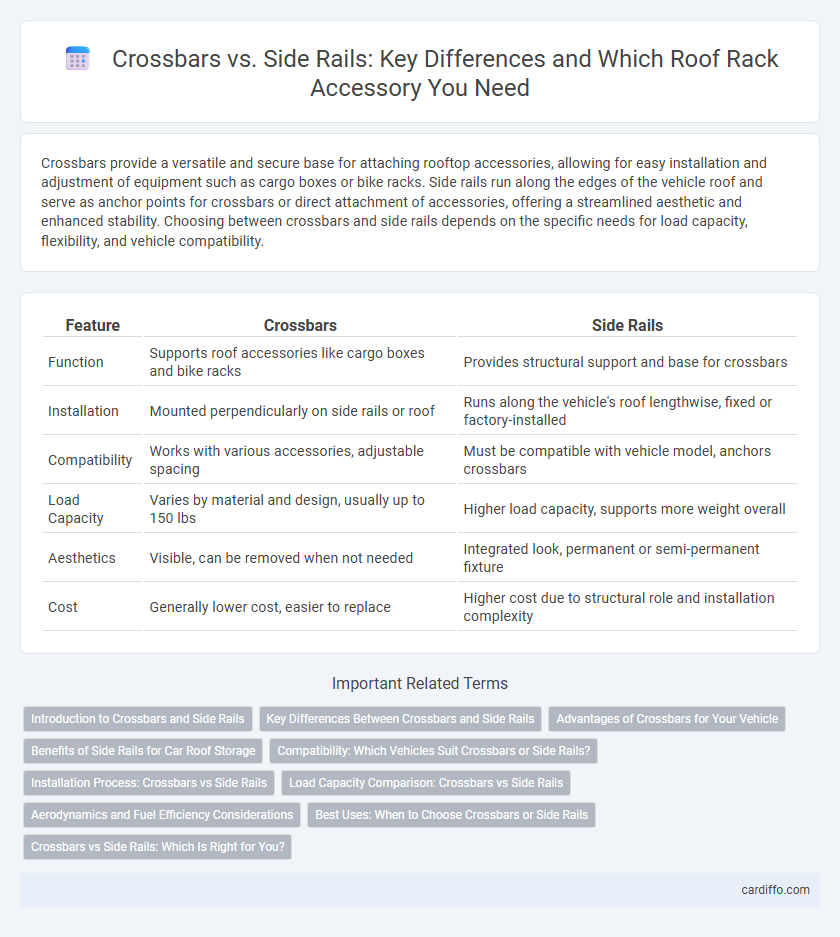Crossbars provide a versatile and secure base for attaching rooftop accessories, allowing for easy installation and adjustment of equipment such as cargo boxes or bike racks. Side rails run along the edges of the vehicle roof and serve as anchor points for crossbars or direct attachment of accessories, offering a streamlined aesthetic and enhanced stability. Choosing between crossbars and side rails depends on the specific needs for load capacity, flexibility, and vehicle compatibility.
Table of Comparison
| Feature | Crossbars | Side Rails |
|---|---|---|
| Function | Supports roof accessories like cargo boxes and bike racks | Provides structural support and base for crossbars |
| Installation | Mounted perpendicularly on side rails or roof | Runs along the vehicle's roof lengthwise, fixed or factory-installed |
| Compatibility | Works with various accessories, adjustable spacing | Must be compatible with vehicle model, anchors crossbars |
| Load Capacity | Varies by material and design, usually up to 150 lbs | Higher load capacity, supports more weight overall |
| Aesthetics | Visible, can be removed when not needed | Integrated look, permanent or semi-permanent fixture |
| Cost | Generally lower cost, easier to replace | Higher cost due to structural role and installation complexity |
Introduction to Crossbars and Side Rails
Crossbars and side rails are essential vehicle accessories designed to enhance cargo carrying capacity. Side rails run parallel along the vehicle's roof edges, providing a mounting base, while crossbars span horizontally, attaching to side rails and supporting loads such as roof boxes, bikes, or kayaks. Selecting the right combination depends on vehicle type and intended cargo, optimizing security and aerodynamics for transport.
Key Differences Between Crossbars and Side Rails
Crossbars are horizontal bars attached across the roof of a vehicle, providing a base for mounting accessories such as bike racks, cargo boxes, or kayak carriers. Side rails run parallel to the length of the vehicle's roof and serve as structural support points to which crossbars are mounted or other accessories are directly attached. The key difference is that crossbars create the actual platform for carrying cargo, while side rails function as fixed anchor points that enhance the versatility and load capacity of the roof rack system.
Advantages of Crossbars for Your Vehicle
Crossbars provide enhanced versatility for transporting oversized items such as kayaks, bikes, and cargo boxes due to their adjustable width and strong load-bearing capacity. They offer a lower profile compared to side rails, reducing wind resistance and improving fuel efficiency during travel. Crossbars also simplify the installation of various rooftop accessories, making them a practical choice for outdoor enthusiasts seeking customizable transport solutions.
Benefits of Side Rails for Car Roof Storage
Side rails offer versatile mounting points that enhance the security and stability of car roof storage by allowing adjustable crossbar placement tailored to various cargo sizes. They provide aerodynamic advantages that reduce wind noise and improve fuel efficiency compared to fixed crossbars. Side rails also facilitate easier access and flexibility for attaching different accessories, making them ideal for transporting bikes, kayaks, or cargo boxes.
Compatibility: Which Vehicles Suit Crossbars or Side Rails?
Crossbars are compatible with a wide range of vehicles, including SUVs, trucks, and sedans equipped with factory-installed or aftermarket roof rails. Side rails typically suit larger vehicles like SUVs and vans that have raised or flush-mounted rails, providing a stable base for mounting crossbars or other accessories. Vehicle-specific fitment guides ensure that the chosen crossbars or side rails match roof dimensions and load capacities for safe and secure transportation.
Installation Process: Crossbars vs Side Rails
Crossbars typically require mounting brackets that attach directly to the vehicle's roof rails, offering a straightforward installation process with minimal tools. Side rails installation often involves securing long bars along the vehicle's roof edges, which may necessitate additional hardware or professional assistance to ensure proper alignment and stability. The choice between crossbars and side rails affects installation time and complexity, with crossbars generally preferred for quicker setup.
Load Capacity Comparison: Crossbars vs Side Rails
Crossbars typically offer a higher load capacity compared to side rails, supporting weights ranging from 100 to 300 pounds depending on the vehicle model and material quality. Side rails primarily serve as a mounting point and structural support for crossbars but generally bear less direct load, often rated around 150 pounds at maximum. Choosing crossbars with high-tensile steel or aluminum construction directly enhances the overall load capacity for roof racks and accessory systems.
Aerodynamics and Fuel Efficiency Considerations
Crossbars typically create more wind resistance compared to side rails, leading to increased drag and reduced fuel efficiency during highway driving. Side rails offer a sleeker profile that minimizes aerodynamic disruption, helping maintain better gas mileage. Choosing side rails over crossbars can result in measurable improvements in fuel consumption, especially on long trips at higher speeds.
Best Uses: When to Choose Crossbars or Side Rails
Crossbars are best for carrying large, flat items like kayaks, cargo boxes, and skis, providing versatility and easy load securing. Side rails work well for heavier cargo and outfitting with specialized accessories, offering a sturdy foundation for racks and tie-downs. Choose crossbars for flexible, everyday use and side rails when vehicle-specific support and maximum load capacity are priorities.
Crossbars vs Side Rails: Which Is Right for You?
Crossbars provide a versatile and adjustable platform for securing various cargo types, making them ideal for temporary or mixed-use needs. Side rails offer a more permanent and sturdy base, often integrated into the vehicle, enhancing load stability and compatibility with specific accessories. Choosing between crossbars and side rails depends on your cargo frequency, vehicle type, and the level of customization required for your transport solutions.
Crossbars vs Side Rails Infographic

 cardiffo.com
cardiffo.com